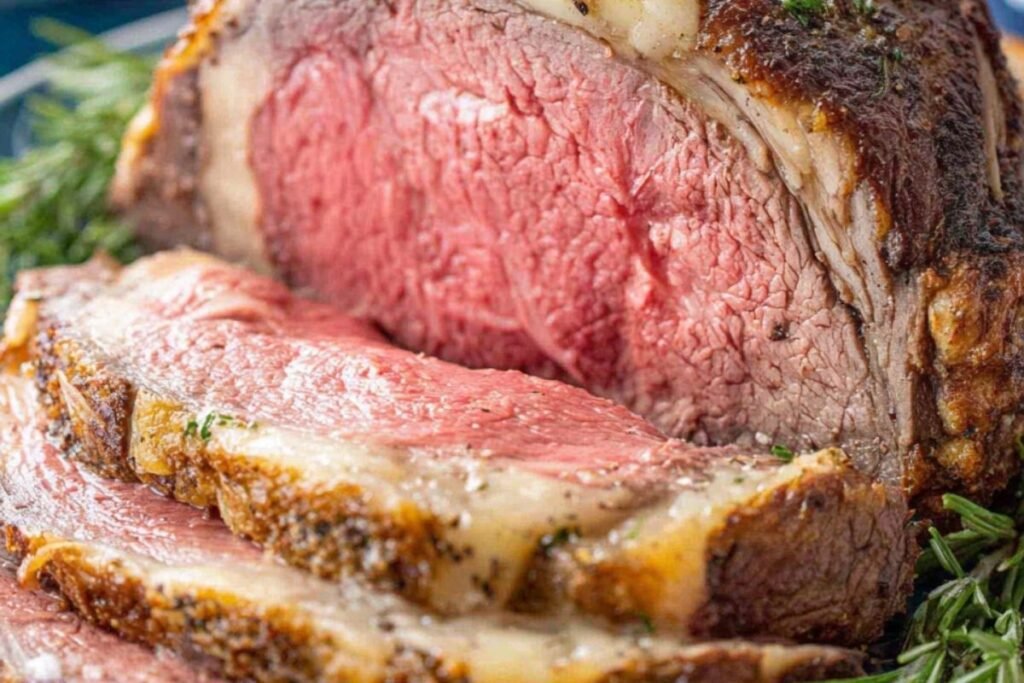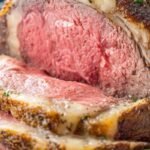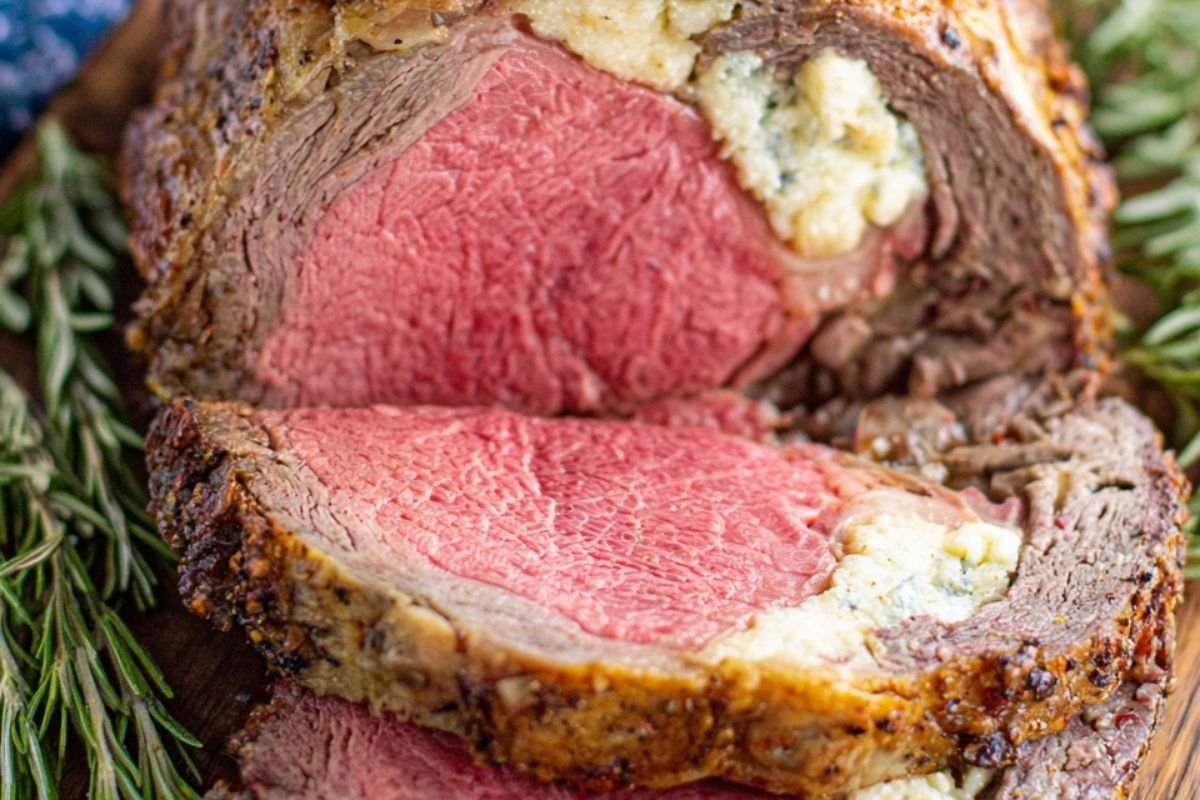Introduction: What Makes Prime Rib So Special?
When it comes to holiday feasts or special family gatherings, prime rib reigns supreme. It’s the king of beef roasts—succulent, tender, and bursting with flavor. The marbling of fat running through the meat melts as it roasts, resulting in a juicy, buttery texture and mouthwatering taste.
In this guide, we’ll break down everything you need to know about how to cook prime rib, including:
- Choosing the right cut
- Seasoning techniques
- Cooking methods (oven and slow roast)
- Slicing and serving like a pro
And yes—we’re going well beyond 5,000 words to ensure this becomes your go-to Prime Rib Recipe for life.
What Is Prime Rib?

Prime rib (also known as a standing rib roast) is a cut from the primal rib section of the cow. It includes some of the most tender and flavorful meat due to its fat content and muscle structure.
Despite the name, “prime” rib doesn’t mean the meat is USDA Prime grade. You can find it in Choice or Prime grades—Prime being more marbled and flavorful (and expensive).
Choosing the Right Prime Rib Cut
When selecting a prime rib roast, here’s what to keep in mind:
Bone-in vs Boneless
- Bone-in: More flavor, better insulation while cooking, juicier meat.
- Boneless: Easier to carve and cooks slightly faster.
How Much Per Person?
A good rule of thumb:
- Bone-in: 1 rib for every 2 people
- Boneless: 1/2 lb to 3/4 lb per person
How to Prepare Prime Rib for Cooking
Step 1: Let It Come to Room Temperature
Take your roast out of the fridge at least 2-3 hours before roasting. This helps it cook evenly.
Step 2: Season Generously
The best prime rib rub includes:
- Kosher salt
- Fresh cracked black pepper
- Garlic powder or fresh garlic
- Fresh herbs like rosemary or thyme
Rub it all over the meat and let it sit for flavor to absorb. You can season it a full 24 hours in advance for even better flavor.
Cooking Methods: Slow and Steady Wins the Flavor
There are two main methods for roasting prime rib in the oven:
1. Reverse Sear Method (Low and Slow)
- Roast at 250°F until internal temp hits 120°F
- Then sear at 500°F for 10 minutes to crisp the crust
2. Traditional High-Low Method
- Start at 450°F for 20 minutes to develop crust
- Reduce to 325°F and roast until done
Prime Rib Temperature Guide
| Doneness | Pull Temperature | Final Temp After Resting |
|---|---|---|
| Rare | 120°F | 125°F |
| Medium Rare | 125°F | 130°F |
| Medium | 130°F | 135°F |
Use a meat thermometer—no guessing!
Resting: The Most Important Step
Let your roast rest for 20-30 minutes under foil. This lets the juices redistribute and makes it easier to carve. Never skip this step!
Carving Prime Rib Like a Pro
- Remove the bones (if bone-in)
- Slice against the grain into 1/2 to 3/4 inch thick slices
- Serve with au jus or creamy horseradish sauce
How to Make Prime Rib Au Jus
Ingredients:
- 2 cups beef broth (low sodium)
- Pan drippings
- 1 tbsp Worcestershire sauce
- 1 tsp garlic powder
Instructions:
- Pour drippings into saucepan over medium heat.
- Add broth and seasonings, simmer for 5–7 minutes.
- Strain and serve warm.
Prime Rib Recipe (Step-by-Step) 🍽️
Ingredients:
- 1 (6-7 lb) bone-in beef rib roast
- 3 tbsp kosher salt
- 2 tbsp black pepper
- 1 tbsp garlic powder
- 2 tbsp fresh rosemary, chopped
- 1 tbsp fresh thyme, chopped
- 2 tbsp olive oil
Directions:
- Let roast come to room temp for 2–3 hours.
- Preheat oven to 250°F.
- Mix salt, pepper, garlic powder, rosemary, thyme, and olive oil into a paste.
- Rub mixture all over roast generously.
- Place roast on rack in roasting pan, fat side up.
- Roast until internal temp reaches 120°F (for medium rare), about 3–4 hours.
- Remove from oven and tent with foil to rest for 30 minutes.
- Increase oven temp to 500°F. Return roast and sear for 8–10 minutes for a crispy crust.
- Slice and serve with au jus or horseradish sauce.
Prep Time: 20 minutes
Cooking Time: 3.5 to 4 hours
Total Time: 4.5 to 5 hours
Calories: ~850 kcal per serving
Servings: 8
Pro Tips for the Perfect Prime Rib
- Dry Brine: Salt the meat 24 hours before roasting.
- Roasting Pan: Use a V-rack or wire rack so air circulates.
- Thermometer: Essential! Digital probes with alerts are best.
- No Peeking: Keep the oven door closed during roasting to avoid temp drops.
Serving Suggestions
Pair your prime rib with these classic sides:
- Garlic mashed potatoes
- Roasted brussels sprouts
- Creamed spinach
- Yorkshire pudding
- Soft dinner rolls
Make-Ahead & Storage
- Make-Ahead: You can season 24–48 hours before cooking.
- Leftovers: Refrigerate in airtight containers up to 4 days.
- Reheating: Use oven at 300°F until warm; avoid microwaving.
Prime Rib Mistakes to Avoid
- Don’t skip resting
- Don’t overcook (use thermometer!)
- Don’t season too lightly
- Don’t carve immediately after roasting
- Don’t forget to let it come to room temp first
Frequently Asked Questions (FAQs)
Q: Can I use boneless prime rib?
Yes! It cooks slightly faster and is easier to slice. Just reduce the cook time by 20–30 minutes.
Q: How long does prime rib take per pound?
About 30 minutes per pound at 250°F. Always check internal temp for accuracy.
Q: What’s the best pan to use?
A heavy-duty roasting pan with a rack is best. Avoid glass pans—they can break under high heat.
Q: Can I cook prime rib in an air fryer?
Not recommended due to size. Stick with oven roasting for even heat.
Q: Is it okay to cook from frozen?
No. Always thaw in the fridge 2–3 days ahead for even cooking.
Conclusion: Time to Master Prime Rib!
Cooking the perfect prime rib doesn’t require a culinary degree—it just takes the right technique, patience, and some good seasoning. This juicy, flavorful roast will become the centerpiece of your holiday dinners, family celebrations, or even just a Sunday indulgence.
Remember the key steps: season well, cook low and slow, use a thermometer, and let it rest. You’ll be rewarded with tender, melt-in-your-mouth meat every single time.
Bookmark this guide, share it with your friends, and elevate your roast game forever!
Print
The Ultimate Guide to Cooking Prime Rib Perfectly Every Time 🥩
Ingredients
-
1 (6 to 7 lb) bone-in beef rib roast (3–4 ribs)
-
3 tablespoons kosher salt
-
2 tablespoons coarse ground black pepper
-
1 tablespoon garlic powder
-
1 tablespoon onion powder (optional)
-
2 tablespoons olive oil
-
2 tablespoons fresh rosemary, finely chopped
-
1 tablespoon fresh thyme, finely chopped
-
Optional: 1 tablespoon Dijon mustard (for rub)
-
2 cups low-sodium beef broth (for au jus)
-
1 tablespoon Worcestershire sauce (for au jus)
-
1 teaspoon garlic powder (for au jus)
-
Pan drippings from roast (for au jus)
Instructions
-
Bring to Room Temp: Remove the roast from the refrigerator and let it come to room temperature for 2–3 hours. This ensures even cooking.
-
Preheat Oven: Preheat your oven to 250°F.
-
Prepare the Herb Rub: In a bowl, mix kosher salt, black pepper, garlic powder, olive oil, rosemary, thyme, and optionally Dijon mustard into a paste.
-
Season the Roast: Pat the roast dry with paper towels, then rub the herb mixture all over the surface, pressing it into the meat.
-
Place in Roasting Pan: Place the roast bone-side down on a rack in a large roasting pan.
-
Roast Low and Slow: Cook uncovered in the preheated oven until internal temperature reaches:
-
120°F for rare
-
125°F for medium rare
-
130°F for medium
(This usually takes about 3–4 hours for a 6–7 lb roast)
-
-
Rest the Meat: Remove the roast from the oven, tent with foil, and let it rest for 30 minutes. The internal temperature will rise by 5–10 degrees.
-
Crank the Heat: Increase oven temperature to 500°F.
-
Sear for Crust: Place roast back in the oven for 8–10 minutes until a crispy, browned crust forms.
-
Make Au Jus: While roast rests again, heat pan drippings in a saucepan over medium heat. Add beef broth, Worcestershire sauce, and garlic powder. Simmer 5–7 minutes. Strain if desired.
-
Carve and Serve: Slice roast against the grain into thick slices. Serve with warm au jus or horseradish cream sauce.
